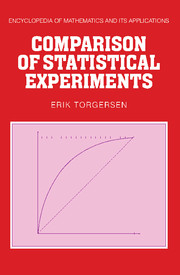Book contents
- Frontmatter
- Contents
- Preface
- Acknowledgments
- 1 Statistical experiments within the measure theoretical framework
- 2 Convexity
- 3 Two-person, zero-sum games
- 4 Statistical decision problems
- 5 Vector lattices
- 6 Deficiencies
- 7 Equivalence, representations and functionals of experiments
- 8 Comparison of linear models
- 9 Majorization and approximate majorization
- 10 Complements: Further examples, problems and comments
- List of symbols
- Author index
- Additional references
- Subject index
9 - Majorization and approximate majorization
Published online by Cambridge University Press: 05 May 2013
- Frontmatter
- Contents
- Preface
- Acknowledgments
- 1 Statistical experiments within the measure theoretical framework
- 2 Convexity
- 3 Two-person, zero-sum games
- 4 Statistical decision problems
- 5 Vector lattices
- 6 Deficiencies
- 7 Equivalence, representations and functionals of experiments
- 8 Comparison of linear models
- 9 Majorization and approximate majorization
- 10 Complements: Further examples, problems and comments
- List of symbols
- Author index
- Additional references
- Subject index
Summary
Introduction
We saw in chapter 6 that a variety of natural and apparently different criteria for comparison actually were equivalent. Thus we found equivalent criteria in terms of overall comparison of risk functions, in terms of Bayes risk for a fixed prior distribution, in terms of sublinear functional, in terms of performance functions of decision rules and in terms of randomizations.
The idea that the underlying distributions which constitute a statistical experiment should be proper probability distributions was of course essential for the interpretation of these results. In particular the interpretation of risk as expected loss depended on this assumption. However if we look over the proofs we see that the arguments do not rely on this. Thus the formal expression of the risk of a decision procedure, as the corresponding bilinear functional evaluated for the underlying distribution and the loss function, remains well defined within a much more general set-up.
We shall now see that such a generalization, or extension, to ‘non-proper’ experiments actually yields interesting results on ‘proper’ experiments. Another benefit is a unified approach to several results concerning systems of inequalities which are frequently encountered in mathematical statistics. The theory we shall formulate here, partly based on Torgersen (1969, 1985), may be considered as a generalization of the theory of majorization as it is described in Marshall & Olkin (1979) and in later generalizations of Dahl (1983) and Karlin & Rinott (1983).
At this point let us briefly indicate some directions of applications.
Example 9.1.1 (Comparison for different losses). Assume that all losses are bounded by 1 and let a, b and e be given functions of the unknown parameter θ.
Information
- Type
- Chapter
- Information
- Comparison of Statistical Experiments , pp. 505 - 585Publisher: Cambridge University PressPrint publication year: 1991
